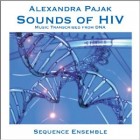The Music of H.I.V.
 Yesterday I came upon something I’d never heard before: Alexandra Pajak, a graduate student at the University of Georgia, merges art and science in a novel way. She composed a new work, the Sounds of HIV, based on the virus’s genetic sequence.
Yesterday I came upon something I’d never heard before: Alexandra Pajak, a graduate student at the University of Georgia, merges art and science in a novel way. She composed a new work, the Sounds of HIV, based on the virus’s genetic sequence.
A CD, produced by Azica records, will be available later this month. A ScienceRoll post, by Bertalan Meskó, clued me into this fascinating project. He shared the artist’s explanation of her work:
Sounds of HIV is a musical translation of the genetic code of HIV, the Human Immunodeficiency Virus. Every segment of the virus is assigned music pitches that correspond to the segment’s scientific properties. In this way, the sounds reflect the true nature of the virus. When listening from beginning to end, the listener hears the entire genome of HIV.
In English, the nucleotides Adenine, Cytosine, Uracil/Thymine, and Guanine are abbreviated with the letters A, C, T, and G. Since A, C, and G are also musical pitches in the Western melodic scale, these pitches were assigned to the matching nucleotides. To form two perfect fifths (C-G and D-A), “D” was arbitrarily assigned to musically represent Uracil. I assigned the pitches of the A minor scale to the amino acids based on their level of attraction to water…
According to a May, 2010 post in the Daily Scan, the artist has assigned pitches to each viral segment’s properties:
…The composition’s Prelude and Postlude correspond to the first and last 100 nucleotides, and the sections named after the proteins (Proteins 1-9) represent translations of the amino acid sequences…
Upon searching further, I tracked down some partial HIV music clips, available now, at ClassicsOnline. The start of the prelude sounds calm and lovely to my rock-trained ears; other portions are distinct and lively.
I look forward to more listening!
Leave a Reply